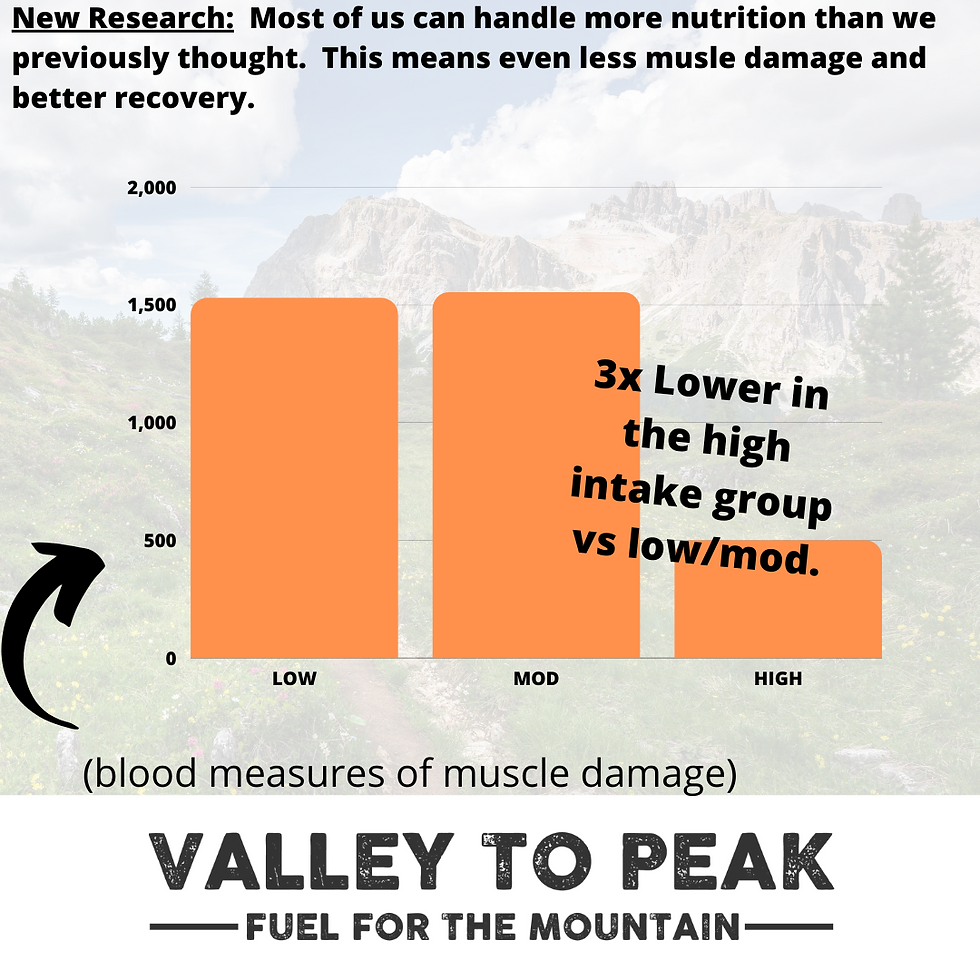FAQ: Single best nutrition tip to prevent muscle damage on long hunts and high-volume training?
- Kyle Kamp

- Dec 10, 2021
- 3 min read

One of the most common questions I get is “how can I prevent muscle loss while training a lot for an upcoming event?” It’s a great question! Who wouldn’t worry about losing something they’ve not only worked so hard for but the VERY thing that is the engine that carries them to do the things they love?
What’s the typical cause of muscle loss with high training volumes?
You could rabbit trail down this topic for hours, but we’d consistently loop back to two factors:
Very intense energy demand on the body and
Too little fuel to provide for #1.
It’s as simple as that.
As a result, the body responds to the stress through a series of less-than-ideal events that results in muscle damage and what we call “internal stressors of exercise”- a fancy term explaining the production of increased stress responses that lead to a less than ideal environment for recovery.
Is there any way to prevent or fix the issue?
Here’s the good news- there are things we can do to remedy the issue. What’s even better news is they’re incredibly simple.
The first would be to provide enough fuel for the demand you’re placing on your body. A key element for doing this is to regularly replace the fuel you’ve used.
Historically, we’ve always suggested doing this by aiming for about 60-90g of carbohydrates every couple of hours. That recommendation would change to every one hour if the event is particularly taxing.
The reason that recommendation came into play is that we’ve known that’s about what the channels in the stomach can handle. If you were to exceed that amount- say 105g of carbohydrate in an hour- the body may be able to possess 60-90g of that, but the remaining amount (15-45g) would sit in the gut and create stomach problems as the carb remained undigested.
….until now….
New research
Last year there was a group of folks who completed a marathon in the mountains at 13,000 feet. During this event, these folks consumed 120g/hour of replacement fuel with very few showing any issues in doing so (11% complained of stomach issues related to the dose).
What’s more is these same groups of folks showed less sign of muscle damage and fewer signs of poor recovery because of the “internal exercise load” (keep in mind these were measured with blood samples, not subjective feelings of the athletes).

What’s it mean?
There are a few take-a-ways I draw from this that may be helpful to you in executing your next big event:
Ensuring there’s fuel in the “tank” is tremendously helpful in not only fueling the endeavor but recovering afterward.
Ensuring there’s adequate fuel prevents damage to the muscle and the cascade of issues we normally tie to overtraining.
You have to balance optimal and practical. 120g of carbohydrate EACH hour for hours on end can not only be ALOT to stomach (volume-wise), but it can also be logistically tough to carry that much fuel.
However, even if you can’t handle 120g/hour (optimal), maybe you could handle 60g/hour (practical). If that’s more than you’re traditionally used to carrying, you’ll see a performance improvement.
Prepare ahead of time. In my experience, increasing carb loads to this amount can take some “gut training”. Experiment before the event as opposed to wining it the day of and hoping things work out for the best….they won’t.
Closing thoughts
The research is interesting, but there’s no question that providing adequate fuel at the right intervals is one of the best bets to keep muscle damage and complications to recovery at bay. What’s more is that the solution is easy, inexpensive, and universally applicable whether you’re training for an endurance trail run, backcountry ski tour, or multi-day backcountry hunt.







![Four Things For All Day Fueling On the Trail to Push Limits [AND BEYOND]](https://static.wixstatic.com/media/86c542_15223e1d702c4e99a820206a997e949b~mv2.png/v1/fill/w_440,h_250,fp_0.50_0.50,q_35,blur_30,enc_avif,quality_auto/86c542_15223e1d702c4e99a820206a997e949b~mv2.webp)
![Four Things For All Day Fueling On the Trail to Push Limits [AND BEYOND]](https://static.wixstatic.com/media/86c542_15223e1d702c4e99a820206a997e949b~mv2.png/v1/fill/w_74,h_42,fp_0.50_0.50,q_95,enc_avif,quality_auto/86c542_15223e1d702c4e99a820206a997e949b~mv2.webp)









![Two Lessons [in] Thirty-Eight Years](https://static.wixstatic.com/media/86c542_f761fabc24e14c689455be138af5be04~mv2.png/v1/fill/w_440,h_250,fp_0.50_0.50,q_35,blur_30,enc_avif,quality_auto/86c542_f761fabc24e14c689455be138af5be04~mv2.webp)
![Two Lessons [in] Thirty-Eight Years](https://static.wixstatic.com/media/86c542_f761fabc24e14c689455be138af5be04~mv2.png/v1/fill/w_74,h_42,fp_0.50_0.50,q_95,enc_avif,quality_auto/86c542_f761fabc24e14c689455be138af5be04~mv2.webp)


![Managing [Nutrition] Extremes in Hostile Mountain Environments](https://static.wixstatic.com/media/86c542_bb938ede21634666bda3fd2472666c08~mv2.png/v1/fill/w_440,h_250,fp_0.50_0.50,q_35,blur_30,enc_avif,quality_auto/86c542_bb938ede21634666bda3fd2472666c08~mv2.webp)
![Managing [Nutrition] Extremes in Hostile Mountain Environments](https://static.wixstatic.com/media/86c542_bb938ede21634666bda3fd2472666c08~mv2.png/v1/fill/w_74,h_42,fp_0.50_0.50,q_95,enc_avif,quality_auto/86c542_bb938ede21634666bda3fd2472666c08~mv2.webp)


Comments